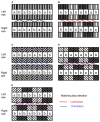Mechanisms for similarity matching in disparity measurement
- PMID: 24409163
- PMCID: PMC3884144
- DOI: 10.3389/fpsyg.2013.01014
Mechanisms for similarity matching in disparity measurement
Abstract
Early neural mechanisms for the measurement of binocular disparity appear to operate in a manner consistent with cross-correlation-like processes. Consequently, cross-correlation, or cross-correlation-like procedures have been used in a range of models of disparity measurement. Using such procedures as the basis for disparity measurement creates a preference for correspondence solutions that maximize the similarity between local left and right eye image regions. Here, we examine how observers' perception of depth in an ambiguous stereogram is affected by manipulations of luminance and orientation-based image similarity. Results show a strong effect of coarse-scale luminance similarity manipulations, but a relatively weak effect of finer-scale manipulations of orientation similarity. This is in contrast to the measurements of depth obtained from a standard cross-correlation model. This model shows strong effects of orientation similarity manipulations and weaker effects of luminance similarity. In order to account for these discrepancies, the standard cross-correlation approach may be modified to include an initial spatial frequency filtering stage. The performance of this adjusted model most closely matches human psychophysical data when spatial frequency filtering favors coarser scales. This is consistent with the operation of disparity measurement processes where spatial frequency and disparity tuning are correlated, or where disparity measurement operates in a coarse-to-fine manner.
Keywords: binocular energy model; binocular vision; correspondence problem; cross-correlation; disparity measurement; similarity.
Figures






Similar articles
-
Cross-matching: a modified cross-correlation underlying threshold energy model and match-based depth perception.Front Comput Neurosci. 2014 Oct 15;8:127. doi: 10.3389/fncom.2014.00127. eCollection 2014. Front Comput Neurosci. 2014. PMID: 25360107 Free PMC article.
-
Evidence for relative disparity matching in the perception of an ambiguous stereogram.J Vis. 2010 Oct 29;10(12):35. doi: 10.1167/10.12.35. J Vis. 2010. PMID: 21047767
-
Shading Beats Binocular Disparity in Depth from Luminance Gradients: Evidence against a Maximum Likelihood Principle for Cue Combination.PLoS One. 2015 Aug 10;10(8):e0132658. doi: 10.1371/journal.pone.0132658. eCollection 2015. PLoS One. 2015. PMID: 26258494 Free PMC article.
-
A unified model for binocular fusion and depth perception.Vision Res. 2021 Mar;180:11-36. doi: 10.1016/j.visres.2020.11.009. Epub 2020 Dec 21. Vision Res. 2021. PMID: 33359897 Free PMC article.
-
Weighted parallel contributions of binocular correlation and match signals to conscious perception of depth.Philos Trans R Soc Lond B Biol Sci. 2016 Jun 19;371(1697):20150257. doi: 10.1098/rstb.2015.0257. Philos Trans R Soc Lond B Biol Sci. 2016. PMID: 27269600 Free PMC article. Review.
Cited by
-
Binocular Depth Judgments on Smoothly Curved Surfaces.PLoS One. 2016 Nov 8;11(11):e0165932. doi: 10.1371/journal.pone.0165932. eCollection 2016. PLoS One. 2016. PMID: 27824895 Free PMC article.
-
Robust natural depth for anticorrelated random dot stereogram for edge stimuli, but minimal reversed depth for embedded circular stimuli, irrespective of eccentricity.PLoS One. 2022 Sep 22;17(9):e0274566. doi: 10.1371/journal.pone.0274566. eCollection 2022. PLoS One. 2022. PMID: 36137132 Free PMC article.
-
Depth perception in disparity-defined objects: finding the balance between averaging and segregation.Philos Trans R Soc Lond B Biol Sci. 2016 Jun 19;371(1697):20150258. doi: 10.1098/rstb.2015.0258. Philos Trans R Soc Lond B Biol Sci. 2016. PMID: 27269601 Free PMC article.
-
Stereo slant discrimination of planar 3D surfaces: Frontoparallel versus planar matching.J Vis. 2022 Apr 6;22(5):6. doi: 10.1167/jov.22.5.6. J Vis. 2022. PMID: 35467704 Free PMC article.
-
Impairment of cyclopean surface processing by disparity-defined masking stimuli.J Vis. 2020 Feb 10;20(2):1. doi: 10.1167/jov.20.2.1. J Vis. 2020. PMID: 32040160 Free PMC article.
References
Grants and funding
LinkOut - more resources
Full Text Sources
Other Literature Sources

